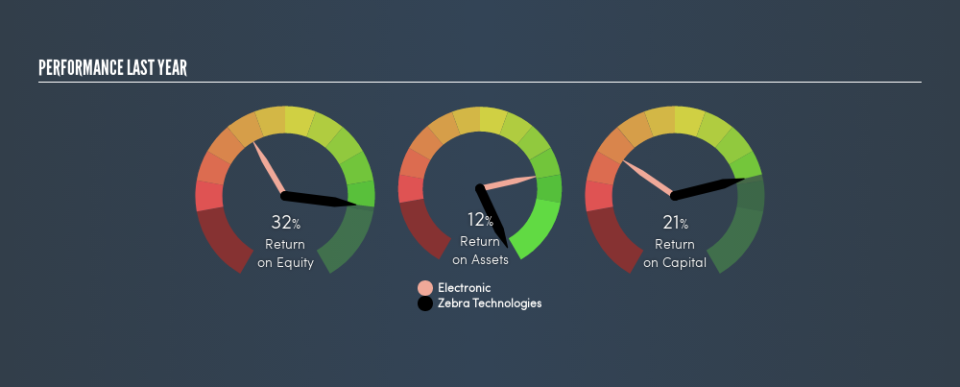Are Zebra Technologies Corporation’s (NASDAQ:ZBRA) High Returns Really That Great?

Today we’ll look at Zebra Technologies Corporation (NASDAQ:ZBRA) and reflect on its potential as an investment. Specifically, we’ll consider its Return On Capital Employed (ROCE), since that will give us an insight into how efficiently the business can generate profits from the capital it requires.
First, we’ll go over how we calculate ROCE. Then we’ll compare its ROCE to similar companies. Finally, we’ll look at how its current liabilities affect its ROCE.
Understanding Return On Capital Employed (ROCE)
ROCE is a measure of a company’s yearly pre-tax profit (its return), relative to the capital employed in the business. Generally speaking a higher ROCE is better. Overall, it is a valuable metric that has its flaws. Renowned investment researcher Michael Mauboussin has suggested that a high ROCE can indicate that ‘one dollar invested in the company generates value of more than one dollar’.
How Do You Calculate Return On Capital Employed?
Analysts use this formula to calculate return on capital employed:
Return on Capital Employed = Earnings Before Interest and Tax (EBIT) ÷ (Total Assets – Current Liabilities)
Or for Zebra Technologies:
0.21 = US$642m ÷ (US$4.3b – US$1.3b) (Based on the trailing twelve months to December 2018.)
So, Zebra Technologies has an ROCE of 21%.
See our latest analysis for Zebra Technologies
Is Zebra Technologies’s ROCE Good?
When making comparisons between similar businesses, investors may find ROCE useful. Using our data, we find that Zebra Technologies’s ROCE is meaningfully better than the 11% average in the Electronic industry. We consider this a positive sign, because it suggests it uses capital more efficiently than similar companies. Regardless of the industry comparison, in absolute terms, Zebra Technologies’s ROCE currently appears to be excellent.
As we can see, Zebra Technologies currently has an ROCE of 21% compared to its ROCE 3 years ago, which was 5.3%. This makes us think about whether the company has been reinvesting shrewdly.
When considering this metric, keep in mind that it is backwards looking, and not necessarily predictive. ROCE can be deceptive for cyclical businesses, as returns can look incredible in boom times, and terribly low in downturns. ROCE is only a point-in-time measure. Since the future is so important for investors, you should check out our free report on analyst forecasts for Zebra Technologies.
Zebra Technologies’s Current Liabilities And Their Impact On Its ROCE
Short term (or current) liabilities, are things like supplier invoices, overdrafts, or tax bills that need to be paid within 12 months. Due to the way ROCE is calculated, a high level of current liabilities makes a company look as though it has less capital employed, and thus can (sometimes unfairly) boost the ROCE. To check the impact of this, we calculate if a company has high current liabilities relative to its total assets.
Zebra Technologies has total assets of US$4.3b and current liabilities of US$1.3b. As a result, its current liabilities are equal to approximately 30% of its total assets. A minimal amount of current liabilities limits the impact on ROCE.
The Bottom Line On Zebra Technologies’s ROCE
Low current liabilities and high ROCE is a good combination, making Zebra Technologies look quite interesting. Of course you might be able to find a better stock than Zebra Technologies. So you may wish to see this free collection of other companies that have grown earnings strongly.
If you like to buy stocks alongside management, then you might just love this free list of companies. (Hint: insiders have been buying them).
We aim to bring you long-term focused research analysis driven by fundamental data. Note that our analysis may not factor in the latest price-sensitive company announcements or qualitative material.
If you spot an error that warrants correction, please contact the editor at editorial-team@simplywallst.com. This article by Simply Wall St is general in nature. It does not constitute a recommendation to buy or sell any stock, and does not take account of your objectives, or your financial situation. Simply Wall St has no position in the stocks mentioned. Thank you for reading.

